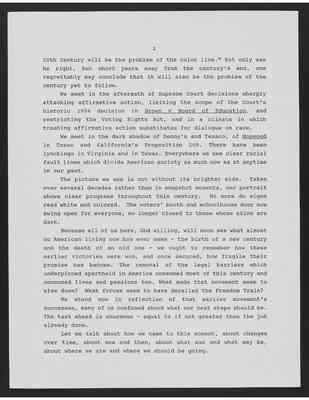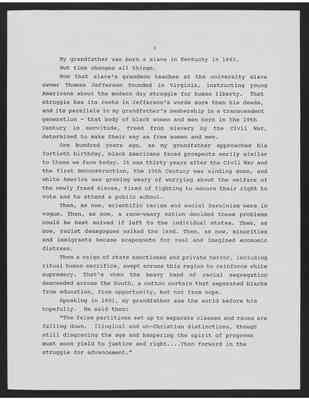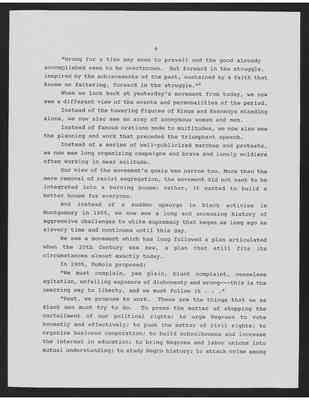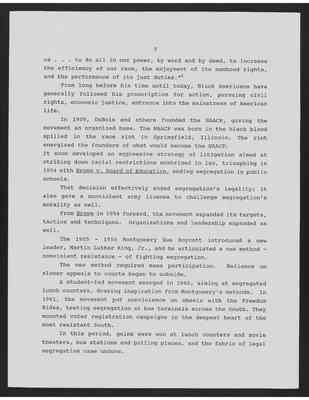Pages
1
3,730
NAACP CONVENTION ADDRESS - PUBLIC MASS MEETING Georgia World Congress Center/Hall C Atlanta, Georgia 7:00PM/July 12, 1998 @ 1998 by Julian Bond
THE NAACP - YESTERDAY, TODAY, & TOMORROW
This is the fourth time the NAACP convention has gathered in Atlanta; we were here in 1962, before that in 1951 and before that in 1920.
In each of those years, the conventioneers were welcomed by a vibrant Atlanta Branch which did much to make this city the attractive place it is today. Rev R.L. White is President.
In 1908, in Nashville, Tennessee, a baby was born. She is my mother, and two weeks ago, she celebrated her 90th birthday!
A year after she was born, the NAACP was born, and now 89 years later, she and the NAACP are in great shape!. I owe both a great debt of gratitude. Her grandchildren are here too.
Here on the podium is another heroine of the struggle for civil rights - Judge Constance Baker Motley.
With Thurgood Marshall and Jack Greenberg and that small band of dedicated lawyers, in small-town courthouses with white and black drinking fountains, she fought for our rights and she won.
We all owe a great debt of gratitude to the courageous woman who saved the NAACP from financial disaster, Myrlie Evers-Williams. She helped salvage us us from financial ruin, and she restored our reputation.
The NAACP today is universally recognized as the premier civil rights organization in the United States, and it is overwhelmingly respected by the people whom we serve.1
But the society we service has serious problems. In those 89 years, we have helped to solve many of them, but the basic problem - racial discrimination - just won't go away.
At the turn of the century, the great scholar, activist and NAACP found W. E. B. DuBois predicted that "the problem of the
2
2
20th Century will be the problem of the color line." Not only was he right, but short years away from the century's end, one regrettably may conclude that it will also be the problem of the century yet to follow.
We meet in the aftermath of Supreme Court decisions sharply attacking affirmative action, limiting the scope of the Court's historic 1954 decision in Brown v. Board of Education, and restricting the Voting Rights Act, and in a climate in which trashing affirmative action substitutes for dialogue on race.
We meet in the dark shadow of Denny's and Texaco, of Hopwood in Texas and California's Proposition 209. There have been lynchings in Virginia and in Texas. Everywhere we see clear racial fault lines which divide American society as much now as at anytime in our past.
The picture we see is not without its brighter side. Taken over several decades rather than in snapshot moments, our portrait shows clear progress throughout this century. No more do signs read white and colored. The voters' booth and schoolhouse door now swing open for everyone, no longer closed to those whose skins are dark.
Because all of us here, God willing, will soon see what almost no American living now has ever seen - the birth of a new century and the death of an old one - we ought to remember how these earlier victories were won, and once secured, how fragile their promise has become. The removal of the legal barriers which underpinned apartheid in America consumed most of this century and consumed lives and passions too. What made that movement seem to slow down? What forces seem to have derailed the Freedom Train?
We stand now in reflection of the earlier movement's successes, many of us confused about what our next steps should be. The task ahead is enormous - equal to if not greater than the job already done.
Let me talk about how we came to this moment, about changes over time, about now and then, about what was and what may be, about where we are and where we should be going.
3
3
My grandfather was born a slave in Kentucky in 1863.
But time changes all things.
Now that slave's grandson teaches at the university slave owner Thomas Jefferson founded in Virginia, instructing young Americans about the modern day struggle for human liberty. That struggle has its roots in Jefferson's words more than his deeds, and its parallels in my grandfather's membership in a transcendent generation - that body of black women and men born in the 19th Century in servitude, freed from slavery by the Civil War, determined to make their way as free women and men.
One hundred years ago, as my grandfather approached his fortieth birthday, black Americans faced prospects eerily similar to those we face today. It was thirty years after the Civil War and the first Reconstruction, the 19th Century was winding down, and white America was growing weary of worrying about the welfare of the newly freed slaves, tired of fighting to secure their right to vote and to attend a public school.
Then, as now, scientific racism and social Darwinism were in vogue. Then, as now, a race-weary nation decided these problems could be best solved if left to the individual states. Then, as now, racism demagogues walked the land. Then, as now, minorities and immigrants became scapegoats for real and imagined economic distress.
Then a reign of state sanctioned and private terror, including ritual human sacrifice, swept across this region to reinforce white supremacy. That's when the heavy hand of racial segretation descended across the South, a cotton curtain that separated blacks from education, from opportunity, but not from hope.
Speaking in 1901, my grandfather saw the world before him hopefully. He said then:
"The false partitions set up to separate classes and races are falling down. Illegal and un-Christian distinctions, though still disgracing the age and hampering the spirit of progress must soon yield to justice and right....Then forward in the struggle for advancement."
4
4
"Wrong for a time may seem to prevail and the good already accomplished seem to be overthrown. But forward in the struggle, inspired by the achievements of the past, sustained by a faith that knows no falter, forward in the struggle."2
When we look back at yesterday's movement from today, we now see a different view of the events and personalities of the period.
Instead of the towering figures of Kings and Kennedys standing alone, we now also see an army of anonymous women and men.
Instead of the famous orations made to multitudes, we now also see the planning and work that preceded the triumphant speech.
Instead of a series of well-publicized marches and protests, we now see long organizing campaigns and brave and lonely soldiers often working in near solitude.
Our view of the movement's goals was narrow too. More than the mere removal of racial segregation, the movement did not want to be integrated into a burning house; rather, it wanted to build a better house for everyone.
And instead of a sudden upsurge in black activism in Montgomery in 1955, we now see a long and unceasing history of aggressive challenges to white supremacy that began as long ago as slavery time and continues until this day.
We see a movement which has long followed a plan articulated when the 20th Century was new, a plan that still fits its circumstances almost exactly today.
In 1905, DuBois proposed:
"We must complain, yes plain, blunt complaint, ceaseless agitation, unfailing exposure of dishonesty and wrong---this is the unerring way to liberty, and we must follow it . . ."
"Next, we propose to work. These are the things that we as Black men must try to do. To press the matter of stopping the curtailment of our political rights; to urge Negroes to vote honestly and effectively; to push the matter of civil rights; to organize business cooperation; to build schoolhouses and increase the interest in education; to bring Negroes and labor unions into mutual understanding; to study Negro history; to attack crime among
5
5
us . . . to do all in our power, by word and by deed, to increase the efficiency of our race, the enjoyment of its manhood rights, and the performance of its just duties."3
From long before his time until today, Black Americans have generally followed his prescription for action, pursuing civil rights, economic justice, entrance into the mainstream of American life.
In 1909, DuBois and others founded the NAACP, giving the movement an organized base. The NAACP was born in the black blood spilled in the race riot of Springfield, Illinois. The riot energized the founders of what would become the NAACP. It soon developed an aggressive strategy of litigation aimed at striking down racial restrictions enshrined in law, triumphing in 1954 with Brown v. Board of Education, ending segregation in public schools.
That decision effectively ended segregation's legality; it also gave a nonviolent army license to challenge segregation's morality as well.
From Brown in 1954 forward, the movement expanded its targets, tactics and techniques. Organizations and leadership expanded as well.
The 1955 - 1956 Montgomery Bus Boycott introduced a new leader, Martin Luther King, Jr., and he articulated a new method - nonviolent resistance - of fighting segregation.
The new method required mass participation. Reliance on slower appeals to courts began to subside.
A student-led movement emerged in 1960, aiming at segregated lunch counters, drawing inspiration from Montgomery's methods. In 1961, the movement put nonviolence on wheels with the Freedom Rides, testing segregation at bus terminals across the South. They mounted voter registration campaigns in the deepest heart of the most resistant South.
In this period, gains were won at lunch counters and movie theaters, bus stations and polling places, and the fabric of legal segregation came undone.




